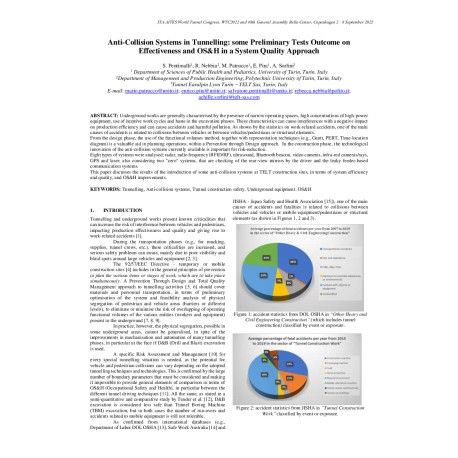Cart
0
0
No document
0,00 €
Total
Document successfully added to your shopping cart
Quantity
Total
There are 0 items in your cart.
There is 1 item in your cart.
Total documents
Total shipping
To be determined
Total
Search & filter
Search for a publication
Search & filter
Anti -Collision Systems in Tunne lling some Preliminary Test s Outcome on
Anti-Collision_Systems_in_Tunnel
A. Sorlini / S. Pentimalli / R. Nebbia / M. Patrucco / E. Pira
Underground works are generally characterised by the presence of narrow operating spaces, high concentrations of high-power equipment, use of iterative work cycles and haste in the excavation phases. These characteristics can cause interferences with a negative impact on production efficiency and can cause accidents and harmful pollution. As shown by the statistics on work-related accidents, one of the main causes of accidents is related to collisions between vehicles or between vehicles/pedestrians or structural elements. From the design phase, the use of the functional volumes method, together with representation techniques (e.g., Gantt, PERT, Time-location diagram) is a valuable aid in planning operations, within a Prevention through Design approach. In the construction phase, the technological innovation of the anti-collision systems currently available is important for risk reduction. Eight types of systems were analysed: radar, radio frequency (RFID/RF), ultrasound, Bluetooth beacon, video cameras, infra-red cameras/rays, GPS and laser; also considering two "zero" systems, that are checking of the rear-view mirrors by the driver and the leaky feeder-based communication systems. This paper discusses the results of the introduction of some anti-collision systems at TELT construction sites, in terms of system efficiency and quality, and OS&H improvements.




